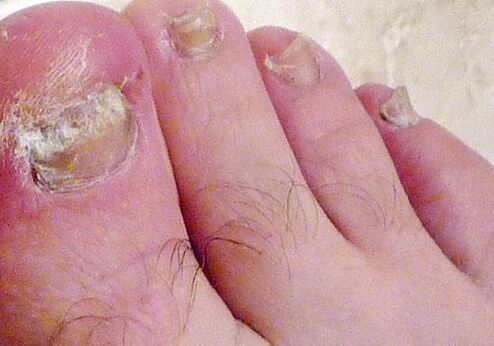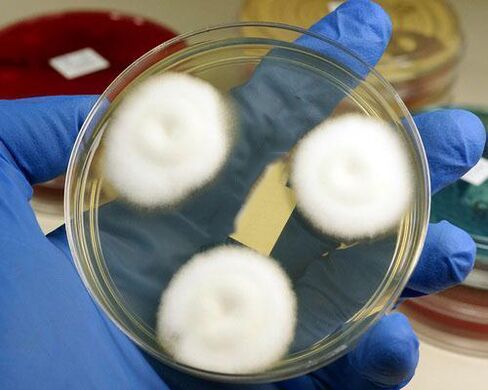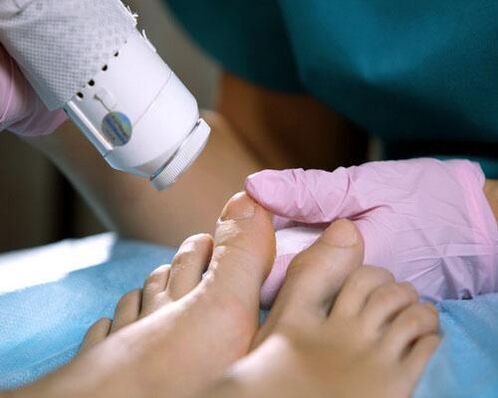
Onychomycosis is a disease of the nails of the hands and feet, caused by representatives of the fungal microflora, gradually leading to the destruction of the nail plate with changes in its structure, color, shape.
The causative agents of onychomycosis include three types of fungi:
- Dermatomycetes. Dermatomycetes are parasitic fungi, whose main representatives are Trichophyton, Microsporum, Epidermophyton. In 80-85% of cases, it is dermatomycetes that become the source of nail fungus.
- Fungi of the genus Candida (similar to yeasts). The Candida fungus is present in the microflora of any human body, however, by its nature, it can start to multiply quickly, causing the fungus on the nails. The Candida fungus infects the nail surface in 8-10% of cases.
- Moldy. Molds are the rarest possible causative agents of nail fungus; they are infected only in 5-6% of cases.
Causes of nail fungus
In 100% of cases, onychomycosis occurs as a result of skin lesions caused by mycotic pathogens. The contact of the skin of the foot with the infected surface leads to the penetration of the fungus through the upper layers of the epithelium in the nail and, consequently, to the subsequent deformation of the nail plate. Depending on the location of the lesion, the following types of onychomycosis are possible:
- The fungus enters the nail bed through the surface of the nail edge. As in the first days of infection it is almost asymptomatic, it is difficult for the patient to notice any changes. But as the fungus grows in the nail bed itself, hyperkeratosis begins to develop. Hyperkeratosis is caused by a change in the color of the nail from light pink to yellowish, the connection between the surface of the nail and the nail bed is also weakened, which leads to delamination, peeling.
- The fungus can enter the nail through the free surface of the nail plate. This occurs when spores have a high keratolytic capacity (quickly destroying keratin). In this case, the infection of the nail occurs much faster than in the first option.
- Through the nail fold (area of the skin adjacent to the nail plate). It is a little less common, however, with this method of infection, the inflammatory process of the nail matrix (root zone) can begin.
Risk factors that can cause fungal nail infection
- flat feet or other features of the structure, development of the foot;
- varicose veins in the legs;
- decreased immunity due to previous illnesses;
- HIV infection;
- increased sweating;
- wear shoes and clothes made of synthetic materials;
- low aeration of the foot. It occurs again due to uncomfortable and tight shoes;
- mechanical damage to the foot;
- scratches, abrasions, open wounds;
- self-removal of an ingrown nail;
- frequent use of antibiotics;
- diseases with candidiasis (mainly in women);
- comorbidities. Diabetes mellitus, thyroid gland dysfunction, dermatological diseases, stomach diseases, pancreas, excess weight can also increase the risk of onychomycosis by up to 6-8 times;
Well, in addition to these factors, there are also ways in which you can get infected directly with nail fungus.
- Use of general personal hygiene items (pumice, sponge, slippers, slippers)
- Visit public saunas, baths, swimming pools, changing rooms without shoes.
- Wear someone else's shoes
- Non-compliance with sterilization standards in beauty salons (mainly pedicures).
Symptoms, forms of onychomycosis
The symptoms of the disease depend on many factors: age, form of onychomycosis, degree of infection, condition of the body as a whole. Symptoms of nail fungus infection are accompanied by itching, burning and skin irritation.
Currently, dermatologists distinguish five main forms of nail fungus damage:
- Hypertrophic. It is characterized by a marked thickening of the nail plate. The thickness of the nail can exceed 3-4 mm - this is due to an increase in the small scales of the skin that grow on the infected surface of the nail. The lateral parts of the nail plate are subject to the greatest destruction; the middle (central) part, on the contrary, thickens. At the edges, the nail begins to disintegrate strongly. Due to hypertrophic damage, the nail becomes curved, narrow and very thick. In addition, there is a sudden change in the color of the nail, accompanied by flaking.
- Normotrophic. It is the easiest way, because the nail, when it is hit by the fungus, does not thicken, but remains the same. Only the color of the nail plate changes. The fungus begins with the appearance of a small yellow spot, which rapidly increases in size. If you do not consult a specialist and do not start treatment, over time the stain will increase in size, gradually conquering the entire area of the nail plate. Since a person can quickly detect a color change, onychomycosis can be diagnosed at a very early stage of the disease.
- Atrophic (Onycholytic). The atrophic form of onychomycosis is accompanied by a marked change in the color of the nail from pink to gray, with the subsequent destruction of the nail structure. It is characterized by rapid progression, eventually leading to complete detachment of the nail plate from the nail bed. In other words, the patient may accidentally pull out or pull out the infected nail and "remove" it completely. The final stage of the atrophic fungus is nail tissue necrosis.
- Lateral and distal. The lateral form is often diagnosed in conjunction with the distal type of fungus. The symbiosis of these varieties leads to discoloration of the nail plate, starting with the appearance of yellowish longitudinal streaks, followed by an increase in the area of the nail lesion. Within 4-5 weeks, in the absence of proper treatment, the nail cells begin to die and the nail itself disintegrates strongly. The final stage of lateral nail damage by a fungus is a complete exposure of the nail bed, which is dangerous with the risk of infection of the mucous membrane.
- Total form of onychomycosis. The total fungus on the nails is the lack of treatment for any of the above types of onychomycosis. Note that the nail changes color very quickly, exfoliates, cracks and then completely detaches from the nail bed. In that case, it is necessary to consult not only a dermatologist, but also a surgeon.
Stages of onychomycosis
To avoid fungal nail infection, it is important to remember that the infection, as well as subsequent nail deformation, never occurs overnight. In medical terms, this is the primary lesion, the normotrophic stage and the hypertrophic stage of the disease.
In the initial stage, the nail is affected only at the edges; at the same time, the size of the affected area does not exceed 2-3 mm. In rare cases, the free edge of the nail can be affected. Before direct damage to the nail, the skin of the feet becomes infected. The patient feels itching, friction and calluses, painful calluses may appear. Over time, the fungus moves from the foot to the nail. If you notice changes at this point and consult a specialist, there is a chance to completely preserve and restore the nail plate in a short time.
The normotrophic stage is the next stage of the disease. Intermediate process in which the thickening of the nail plate has not yet started, but the affected areas of the nail are already noticeable. The affected areas can be small (2-4 mm) or can reach larger sizes (more than 5 mm). Most of the time, they are expressed in the form of thin vertical stripes with a yellowish tint. The first manifestation of the fungus on the nails is precisely the color change: it can be noticed quickly and the treatment can be started at the right time.
The final stage of onychomycosis is the hypertrophic stage of the disease. It starts with the formation of a small spot under the nail, which then grows very quickly. It may be accompanied by an inflammatory process that occurs in parallel with the formation of purulent sacs. The nail plate thickens, disintegrates, exfoliates, then it becomes noticeably thinner and, finally, the nail cells die and their exfoliation is complete.
Important: the danger of hypertrophic nail damage also lies in the possibility of damage to the surrounding skin and the transition to a chronic plane. But such development of events is only possible in the absence of timely medical intervention and subsequent treatment of nail fungus.
Nail fungus treatment
The most common are several antifungal drugs. The mechanism of action of these drugs is reduced not only to the direct destruction of the spores, but also to the accumulation of the active substance in the nail plate itself. This prevents relapse and protects your legs from possible future injuries.
Before choosing one or the other medication, it is necessary to go through a microbiological culture definitively with the identification of the type of nail fungus, make a complete diagnosis and consult a dermatologist.

In most modern dermatological clinics, the following methods are used to diagnose onychomycosis:
- KOH microscopy
- High-precision PCR diagnostics
The dermatologist, before prescribing a specific medication, must take into consideration the nature of the fungal infection, the type of onychomycosis, the time elapsed from the moment of infection and much more.
The most commonly used treatment methods: medicines, lasers and traditional medicine.
Medication
Among the antimycotic drugs, the most widespread are varnishes, ointments and tablets.
In the early stages of the fungus, it is recommended to use topical preparations, among which antifungal varnishes occupy a prominent place.
Important: If a doctor has prescribed an antifungal varnish, the procedures should never be omitted, otherwise the desired effect will not be achieved.
In addition to varnishes, there are also special ointments and gels that have the same antifungal effect. Ointments also belong to topical preparations. Most of the time, experts prescribe ointments. The ointment should be applied to the affected areas of the nail and foot for a period of time. The exact treatment time is prescribed by a specialist.
There are also antifungal pills. Unlike ointments and varnishes, pills are general-purpose drugs that are taken orally. The most commonly prescribed antifungal pills are: Most of the time, the pills are prescribed not in the early stages of infection, but at a later date, when the fungus has entered the normotrophic stage.
Laser fungus treatment

Currently, some clinics offer hardware treatment for nail fungus using a laser. Penetrating the subungual surface, the laser beam heats it up to the growth zone, not only killing the fungus, but also stimulating the growth of a new nail. Research by scientists has shown that with systematic heating of the nail plate to a temperature of 60-70 degrees, fungal microorganisms die. A similar thermal effect without damaging the surrounding tissues can only be achieved with the aid of laser radiation, since the laser beam has a length that reacts only to the cells affected by mycoses. Although the laser exposure method to the lesion promises complete elimination of the nail fungus, dermatologists, as a rule, recommend several sessions of this type of treatment. Compared to drug therapy, this method is much more expensive and is therefore not suitable for everyone.
And for those who are too lazy to see a doctor, there are remedies from the arsenal of traditional medicine
Experts advise the adoption of popular methods exclusively in conjunction with traditional systemic continuous treatment. These resources can be used as preventive measures to eliminate the likelihood of recurrence of the fungus in the future.
Here are some recipes, whose effectiveness in treating nail fungus is likely, but not necessary at all. However, in the absence of other opportunities to combat onychomycosis, it is not prohibited to use these simple recommendations.
- The affected areas of the nail plate are treated with 5% iodine solution twice a day. When iodine is applied, a slight tingling and burning sensation can be felt. If the discomfort intensifies, treatment should be stopped and other treatment methods should be consulted.
- A 20% tincture is made from propolis and applied to the areas of the skin and nails affected by the fungus. The action of propolis is that it promotes the rapid regeneration of damaged cells and the restoration of the nail. The effect of propolis becomes noticeable after a few applications.
- One of the best known ways to fight the fungus on your own is to use kombucha. To prepare a compress, it is necessary to cut a small piece of ripe kombucha, use a bandage or gauze bandage to tie the mushroom to the affected nail and leave it overnight. In the morning, untie the dressing and remove the particles from the dead nail. After that, it is necessary to treat the affected area and the surrounding skin with an iodine solution or any other disinfectant. It is recommended to continue processing the nail with kombucha for 3-4 weeks.
Prevention of fungal nail infection
- Any disease, including onychomycosis, is easier to prevent than to cure. To protect yourself from nail fungus and minimize the risk of infection, you should follow simple preventive measures that will help you stay healthy.
- Firstly, it is the observance of personal hygiene, especially in public places. This also applies to your own apartment and, even more so, to public places like saunas and baths. You should always wear individual slippers, use your own loofah and pumice to care for the heel.
- If you notice excessive perspiration in your feet, you should change your shoes or use special cooling insoles. These insoles have a porous structure, so they normalize air circulation.
- Inspect your feet regularly for micro-cracks, scratches and cuts. If scratches are found, it is necessary to treat the area with antiseptics (iodine alcohol solution and others).
Nail fungus, like many other diseases, may not appear immediately, so it is very important to monitor the condition of the nails and the skin of the feet. And it is best to carefully follow all prescribed preventive measures - these simple actions in the future will save time and money spent on treatment.





























